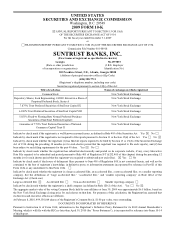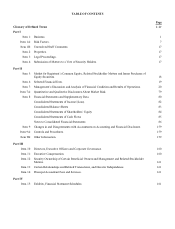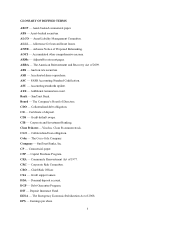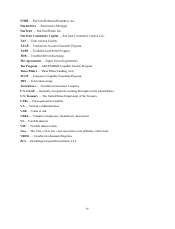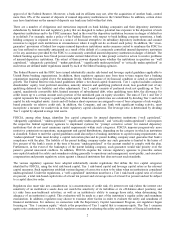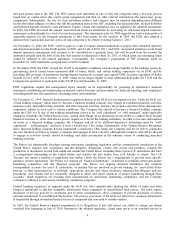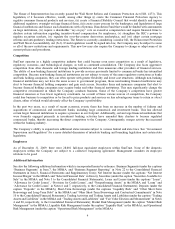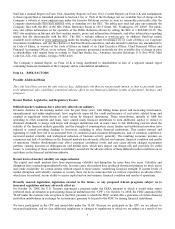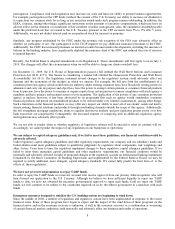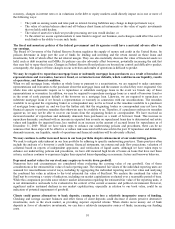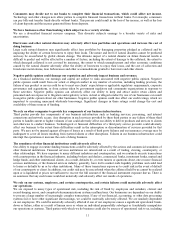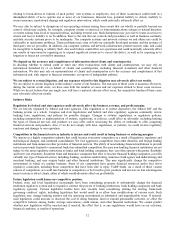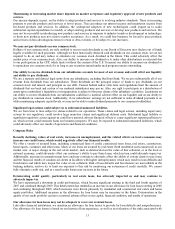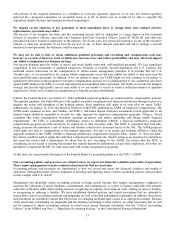SunTrust 2009 Annual Report Download - page 21
Download and view the complete annual report
Please find page 21 of the 2009 SunTrust annual report below. You can navigate through the pages in the report by either clicking on the pages listed below, or by using the keyword search tool below to find specific information within the annual report.order for the banking subsidiary to collect overdraft fees. Overdraft fees have in the past represented a significant amount of
noninterest fees collected by the Company’s banking subsidiary. In addition, additional legislation is currently being debated
in Congress that would further restrict the Company’s banking subsidiary from collecting overdraft fees or limit the amount
of overdraft fees that that may be collected by the Company’s banking subsidiary.
The Company is subject to the rules and regulations promulgated under the EESA by virtue of the Company’s sale of
preferred stock to the U.S. Treasury under the U.S. Treasury’s CPP. Additional information relating to the restrictions on
dividends and redemptions is included in the information set forth in Item 7 of this report under the caption, “Liquidity
Risk.” Furthermore, under rules and regulations of EESA to which the Company is subject, no dividends may be declared or
paid on the Company’s common stock and the Company may not repurchase or redeem any common stock unless dividends
due with respect to Senior Preferred Shares have been paid in full. Moreover, the consent of the U.S. Treasury will be
required for any increase in the per share dividends on the Company’s common stock, beyond the per share dividend
declared prior to October 14, 2008 ($0.77 per share per quarter) until the third anniversary of the date of U.S. Treasury’s
investment; unless prior to the third anniversary, the Senior Preferred Shares are redeemed in whole or the U.S. Treasury has
transferred all of its shares to third parties. Under this provision, the Company could reduce its dividend and subsequently
restore it to no more than $0.77 per share per quarter at any time. Additionally, if the Company pays a dividend in excess of
$0.54 per share per quarter before the tenth anniversary then the anti-dilution provisions of the U.S. Treasury’s warrants will
reduce its exercise price and increase the number of shares issuable upon exercise of the warrant.
Because of the Company’s participation in the CPP, the U.S. Treasury is permitted to determine whether the public
disclosure required for the Company with respect to the Company’s off-balance sheet transactions, derivative instruments,
contingent liabilities and similar sources of exposure are adequate to provide the public sufficient information as to the true
financial position of the Company. If the U.S. Treasury were to determine that such disclosure is not adequate for such
purpose, the U.S. Treasury will make additional recommendations for additional disclosure requirements to the Federal
Reserve, the Company’s primary federal regulator.
Because of the Company’s participation in the CPP, the Company is subject to certain restrictions on its executive
compensation practices, which are discussed in Item 11 of this report.
On October 22, 2009, the Federal Reserve published guidance for structuring incentive compensation arrangements at
financial organizations. All financial institutions, not just companies that participated in the CPP, and even financial
institutions which have repaid their CPP investments, would be subject to this guidance. The guidance does not set forth any
formulas or pay caps, but contains certain principles which companies would be required to follow with respect to,
employees and groups of employees that may expose the organization to material amounts of risk. The three primary
principles are (i) balanced risk-taking incentives, (ii) compatibility with effective controls and risk management, and
(iii) strong corporate governance. The Federal Reserve is conducting a special review of incentive compensation practices at
large, complex banking organizations and is working with such organizations to review, analyze and provide input into their
incentive compensation arrangements.
On January 14, 2010, the Obama administration announced a proposal to impose a Financial Crisis Responsibility Fee on
those financial institutions that benefited extraordinarily from recent actions taken by the U.S. government to stabilize the
financial system. If implemented, the Financial Crisis Responsibility Fee will only be applied to firms with over $50 billion
in consolidated assets, and, therefore, by its terms would apply to the Company. Such Financial Crisis Responsibility Fee
would be collected by the Internal Revenue Service and would be approximately fifteen basis points, or 0.15%, of an amount
calculated by subtracting a covered institution’s Tier 1 capital and FDIC-assessed deposits (and/or an adjustment for
insurance liabilities covered by state guarantee funds) from such institution’s total assets.
The Financial Crisis Responsibility Fee, if implemented as proposed by the Obama administration, would go into effect on
June 30, 2010 and remain in place for at least ten years. The U.S. Treasury would be asked to report after five years on the
effectiveness of the Financial Crisis Responsibility Fee as well as its progress in repaying projected losses to the U.S.
government as a result of TARP. If losses to the U.S. government as a result of TARP have not been recouped after ten years,
the Financial Crisis Responsibility Fee would remain in place until such losses have been recovered.
The Company’s non-banking subsidiaries are regulated and supervised by various other regulatory bodies. For example,
STRH is a broker-dealer registered with the SEC and the FINRA. STIS is also a broker-dealer and investment adviser
registered with the SEC and a member of the FINRA. RidgeWorth and several of RidgeWorth’s subsidiaries are investment
advisers registered with the SEC.
In addition, there have been a number of legislative and regulatory proposals that would have an impact on the operation of
bank/financial holding companies and their bank and non-bank subsidiaries. It is impossible to predict whether or in what
form these proposals may be adopted in the future and, if adopted, what their effect will be on us.
5


